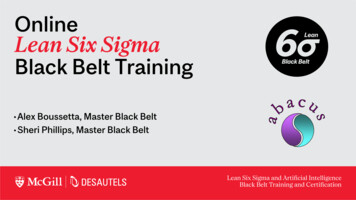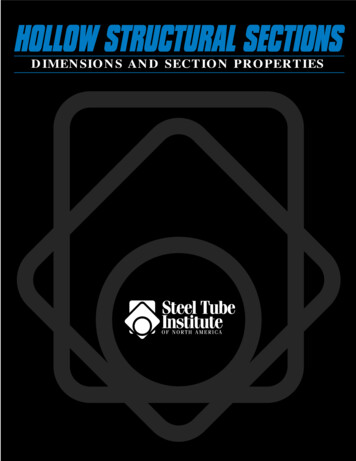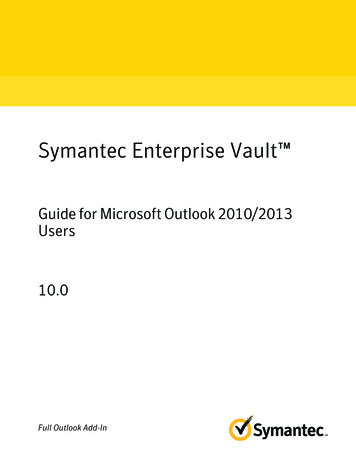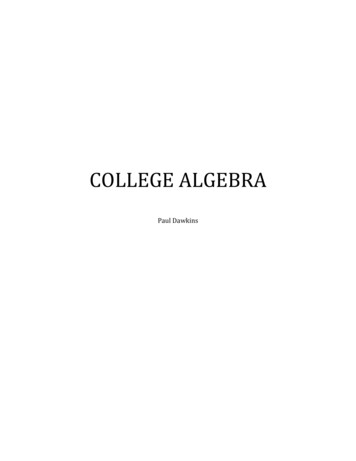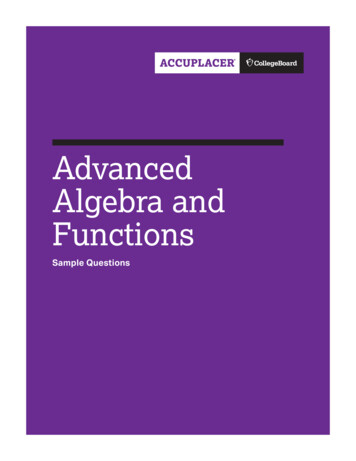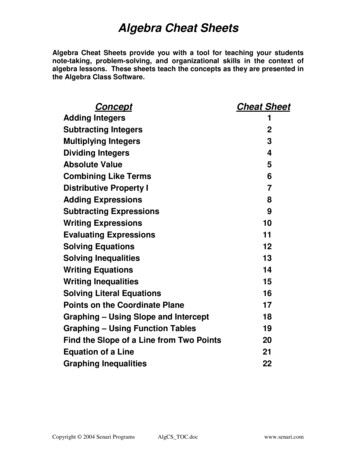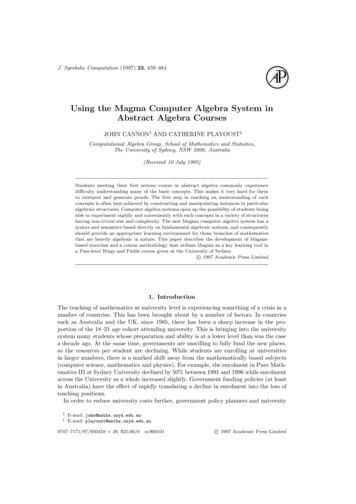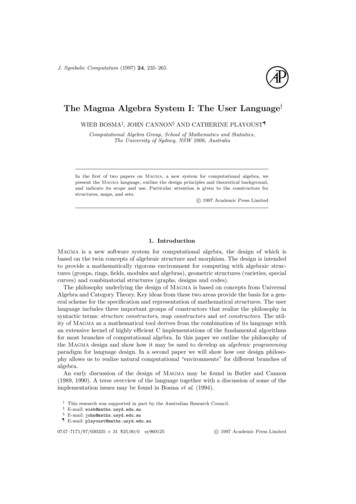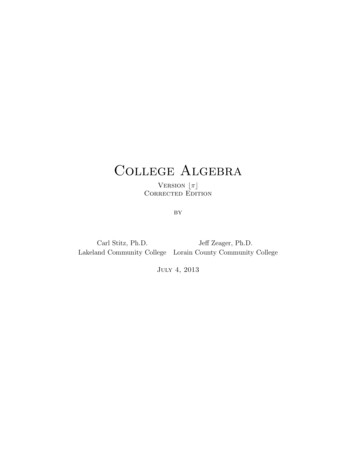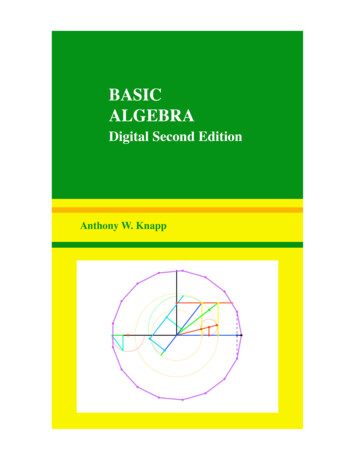
Transcription
Basic Algebra
Digital Second EditionsBy Anthony W. KnappBasic AlgebraAdvanced AlgebraBasic Real Analysis,with an appendix “Elementary Complex Analysis”Advanced Real Analysis
Anthony W. KnappBasic AlgebraAlong with a Companion Volume Advanced AlgebraDigital Second Edition, 2016Published by the AuthorEast Setauket, New York
Anthony W. Knapp81 Upper Sheep Pasture RoadEast Setauket, N.Y. 11733–1729, U.S.A.Email to: aknapp@math.stonybrook.eduHomepage: www.math.stonybrook.edu/ aknappTitle: Basic AlgebraCover: Construction of a regular heptadecagon, the steps shown in color sequence; see page 505.Mathematics Subject Classification (2010): 15–01, 20–01, 13–01, 12–01, 16–01, 08–01, 18A05,68P30.First Edition, ISBN-13 978-0-8176-3248-9c 2006 Anthony W. KnappPublished by Birkhäuser BostonDigital Second Edition, not to be sold, no ISBNc 2016 Anthony W. KnappPublished by the AuthorAll rights reserved. This file is a digital second edition of the above named book. The text, images,and other data contained in this file, which is in portable document format (PDF), are proprietary tothe author, and the author retains all rights, including copyright, in them. The use in this file of tradenames, trademarks, service marks, and similar items, even if they are not identified as such, is notto be taken as an expression of opinion as to whether or not they are subject to proprietary rights.All rights to print media for the first edition of this book have been licensed to Birkhäuser Boston,c/o Springer Science Business Media Inc., 233 Spring Street, New York, NY 10013, USA, andthis organization and its successor licensees may have certain rights concerning print media for thedigital second edition. The author has retained all rights worldwide concerning digital media forboth the first edition and the digital second edition.The file is made available for limited noncommercial use for purposes of education, scholarship, andresearch, and for these purposes only, or for fair use as understood in the United States copyright law.Users may freely download this file for their own use and may store it, post it online, and transmit itdigitally for purposes of education, scholarship, and research. They may not convert it from PDF toany other format (e.g., EPUB), they may not edit it, and they may not do reverse engineering with it.In transmitting the file to others or posting it online, users must charge no fee, nor may they includethe file in any collection of files for which a fee is charged. Any exception to these rules requireswritten permission from the author.Except as provided by fair use provisions of the United States copyright law, no extracts or quotationsfrom this file may be used that do not consist of whole pages unless permission has been granted bythe author (and by Birkhäuser Boston if appropriate).The permission granted for use of the whole file and the prohibition against charging fees extend toany partial file that contains only whole pages from this file, except that the copyright notice on thispage must be included in any partial file that does not consist exclusively of the front cover page.Such a partial file shall not be included in any derivative work unless permission has been grantedby the author (and by Birkhäuser Boston if appropriate).Inquiries concerning print copies of either edition should be directed to Springer Science BusinessMedia Inc.iv
To SusanandTo My Children, Sarah and William,andTo My Algebra Teachers:Ralph Fox, John Fraleigh, Robert Gunning,John Kemeny, Bertram Kostant, Robert Langlands,Goro Shimura, Hale Trotter, Richard Williamson
CONTENTSContents of Advanced AlgebraPreface to the Second EditionPreface to the First EditionList of FiguresDependence Among ChaptersStandard NotationGuide for the ReaderPRELIMINARIES ABOUT THE INTEGERS,POLYNOMIALS, AND MATRICES1. Division and Euclidean Algorithms2. Unique Factorization of Integers3. Unique Factorization of Polynomials4. Permutations and Their Signs5. Row Reduction6. Matrix Operations7. ProblemsxxixiiixviixixxxxxiVECTOR SPACES OVER Q, R, AND C1. Spanning, Linear Independence, and Bases2. Vector Spaces Defined by Matrices3. Linear Maps4. Dual Spaces5. Quotients of Vector Spaces6. Direct Sums and Direct Products of Vector Spaces7. Determinants8. Eigenvectors and Characteristic Polynomials9. Bases in the Infinite-Dimensional Case10. ProblemsIII. INNER-PRODUCT SPACES1. Inner Products and Orthonormal Sets2. Adjoints3. Spectral Theorem4. 114915192430
viiiContentsIV.GROUPS AND GROUP ACTIONS1. Groups and Subgroups2. Quotient Spaces and Homomorphisms3. Direct Products and Direct Sums4. Rings and Fields5. Polynomials and Vector Spaces6. Group Actions and Examples7. Semidirect Products8. Simple Groups and Composition Series9. Structure of Finitely Generated Abelian Groups10. Sylow Theorems11. Categories and Functors12. HEORY OF A SINGLE LINEAR TRANSFORMATION1. Introduction2. Determinants over Commutative Rings with Identity3. Characteristic and Minimal Polynomials4. Projection Operators5. Primary Decomposition6. Jordan Canonical Form7. Computations with Jordan Form8. Problems211211215218226228231238241VI.MULTILINEAR ALGEBRA1. Bilinear Forms and Matrices2. Symmetric Bilinear Forms3. Alternating Bilinear Forms4. Hermitian Forms5. Groups Leaving a Bilinear Form Invariant6. Tensor Product of Two Vector Spaces7. Tensor Algebra8. Symmetric Algebra9. Exterior Algebra10. Problems248249253256258260263277283291295VII. ADVANCED GROUP THEORY1. Free Groups2. Subgroups of Free Groups3. Free Products4. Group Representations306306317322329
ContentsVII. ADVANCED GROUP THEORY (Continued)5. Burnside’s Theorem6. Extensions of Groups7. ProblemsVIII. COMMUTATIVE RINGS AND THEIR MODULES1. Examples of Rings and Modules2. Integral Domains and Fields of Fractions3. Prime and Maximal Ideals4. Unique Factorization5. Gauss’s Lemma6. Finitely Generated Modules7. Orientation for Algebraic Number Theory andAlgebraic Geometry8. Noetherian Rings and the Hilbert Basis Theorem9. Integral Closure10. Localization and Local Rings11. Dedekind Domains12. ProblemsIX.FIELDS AND GALOIS THEORY1. Algebraic Elements2. Construction of Field Extensions3. Finite Fields4. Algebraic Closure5. Geometric Constructions by Straightedge and Compass6. Separable Extensions7. Normal Extensions8. Fundamental Theorem of Galois Theory9. Application to Constructibility of Regular Polygons10. Application to Proving the Fundamental Theorem of Algebra11. Application to Unsolvability of Polynomial Equations withNonsolvable Galois Group12. Construction of Regular Polygons13. Solution of Certain Polynomial Equations with SolvableGalois Group14. Proof That Is Transcendental15. Norm and Trace16. Splitting of Prime Ideals in Extensions17. Two Tools for Computing Galois Groups18. 515519526532539
xX.ContentsMODULES OVER NONCOMMUTATIVE RINGS1. Simple and Semisimple Modules2. Composition Series3. Chain Conditions4. Hom and End for Modules5. Tensor Product for Modules6. Exact Sequences7. ProblemsAPPENDIXA1. Sets and FunctionsA2. Equivalence RelationsA3. Real NumbersA4. Complex NumbersA5. Partial Orderings and Zorn’s LemmaA6. CardinalityHints for Solutions of ProblemsSelected ReferencesIndex of NotationIndexCONTENTS OF ADVANCED ALGEBRAI.II.III.IV.V.VI.VII.VIII.IX.X.Transition to Modern Number TheoryWedderburn–Artin Ring TheoryBrauer GroupHomological AlgebraThree Theorems in Algebraic Number TheoryReinterpretation with Adeles and IdelesInfinite Field ExtensionsBackground for Algebraic GeometryThe Number Theory of Algebraic CurvesMethods of Algebraic 610615715717721
PREFACE TO THE SECOND EDITIONIn the years since publication of the first edition of Basic Algebra, many readershave reacted to the book by sending comments, suggestions, and corrections.People especially approved of the inclusion of some linear algebra before anygroup theory, and they liked the ideas of proceeding from the particular to thegeneral and of giving examples of computational techniques right from the start.They appreciated the overall comprehensive nature of the book, associating thisfeature with the large number of problems that develop so many sidelights andapplications of the theory.Along with the general comments and specific suggestions were corrections,and there were enough corrections, perhaps a hundred in all, so that a secondedition now seems to be in order. Many of the corrections were of minor matters,yet readers should not have to cope with errors along with new material. Fortunately no results in the first edition needed to be deleted or seriously modified,and additional results and problems could be included without renumbering.For the first edition, the author granted a publishing license to BirkhäuserBoston that was limited to print media, leaving the question of electronic publication unresolved. The main change with the second edition is that the questionof electronic publication has now been resolved, and a PDF file, called the “digitalsecond edition,” is being made freely available to everyone worldwide for personaluse. This file may be downloaded from the author’s own Web page and fromelsewhere.The main changes to the text of the first edition of Basic Algebra are as follows: The corrections sent by readers and by reviewers have been made. The mostsignificant such correction was a revision to the proof of Zorn’s Lemma, theearlier proof having had a gap. A number of problems have been added at the ends of the chapters, most ofthem with partial or full solutions added to the section of Hints at the back ofthe book. Of particular note are problems on the following topics:(a) (Chapter II) the relationship in two and three dimensions between determinants and areas or volumes,(b) (Chapters V and IX) further aspects of canonical forms for matrices andlinear mappings,(c) (Chapter VIII) amplification of uses of the Fundamental Theorem ofFinitely Generated Modules over principal ideal domains,xi
xiiPreface to the Second Edition(d) (Chapter IX) the interplay of extension of scalars and Galois theory,(e) (Chapter IX) properties and examples of ordered fields and real closedfields. Some revisions have been made to the chapter on field theory (Chapter IX).It was originally expected, and it continues to be expected, that a reader whowants a fuller treatment of fields will look also at the chapter on infinitefield extensions in Advanced Algebra. However, the original placement of thebreak between volumes left some possible confusion about the role of “normalextensions” in field theory, and that matter has now been resolved. Characteristic polynomials initially have a variable as a reminder of howthey arise from eigenvalues. But it soon becomes important to think of themas abstract polynomials, not as polynomial functions. The indeterminatehad been left as throughout most of the book in the original edition, andsome confusion resulted. The indeterminate is now called X rather thanfrom Chapter V on, and characteristic polynomials have been treatedunambiguously thereafter as abstract polynomials. Occasional paragraphs have been added that point ahead to material inAdvanced Algebra.The preface to the first edition mentioned three themes that recur throughoutand blend together at times: the analogy between integers and polynomials inone variable over a field, the interplay between linear algebra and group theory,and the relationship between number theory and geometry. A fourth is the gentlemention of notions in category theory to tie together phenomena that occur indifferent areas of algebra; an example of such a notion is “universal mappingproperty.” Readers will benefit from looking for these and other such themes,since recognizing them helps one get a view of the whole subject at once.It was Benjamin Levitt, Birkhäuser mathematics editor in New York, whoencouraged the writing of a second edition, who made a number of suggestionsabout pursuing it, and who passed along comments from several anonymousreferees about the strengths and weaknesses of the book. I am especially gratefulto those readers who have sent me comments over the years. Many corrections andsuggestions were kindly pointed out to the author by Skip Garibaldi of EmoryUniversity and Ario Contact of Shiraz, Iran. The long correction concerningZorn’s Lemma resulted from a discussion with Qiu Ruyue. The typesetting wasdone by the program Textures using AMS-TEX, and the figures were drawn withMathematica.Just as with the first edition, I invite corrections and other comments fromreaders. For as long as I am able, I plan to point to a list of known correctionsfrom my own Web page, www.math.stonybrook.edu/ aknapp.A. W. KNAPPJanuary 2016
PREFACE TO THE FIRST EDITIONBasic Algebra and its companion volume Advanced Algebra systematically develop concepts and tools in algebra that are vital to every mathematician, whetherpure or applied, aspiring or established. These two books together aim to give thereader a global view of algebra, its use, and its role in mathematics as a whole.The idea is to explain what the young mathematician needs to know about algebrain order to communicate well with colleagues in all branches of mathematics.The books are written as textbooks, and their primary audience is students whoare learning the material for the first time and who are planning a career in whichthey will use advanced mathematics professionally. Much of the material in thebooks, particularly in Basic Algebra but also in some of the chapters of AdvancedAlgebra, corresponds to normal course work. The books include further topicsthat may be skipped in required courses but that the professional mathematicianwill ultimately want to learn
Basic Algebra Advanced Algebra Basic Real Analysis, with an appendix “Elementary Complex Analysis” Advanced Real Analysis. Anthony W. Knapp Basic Algebra Along with a Companion Volume Advanced Algebra Digital Second Edition, 2016 Published by the Author East Setauket, New York. Anthony W. Knapp 81 Upper Sheep Pasture Road East Setauket, N.Y. 11733–1729, U.S.A. Email to:
